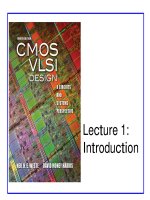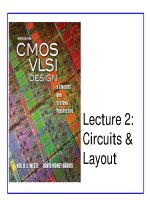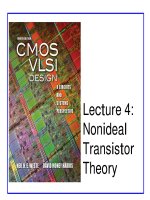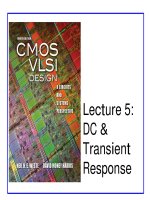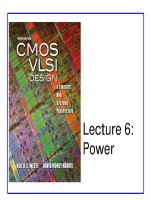CMOS VLSI Design - Lecture 2: Circuits & Layout docx
Bạn đang xem bản rút gọn của tài liệu. Xem và tải ngay bản đầy đủ của tài liệu tại đây (1.15 MB, 45 trang )
Lecture 2:
Circuits &
Layout
CMOS VLSI Design
4th Ed.
1: Circuits & Layout 2
Outline
A Brief History
CMOS Gate Design
Pass Transistors
CMOS Latches & Flip-Flops
Standard Cell Layouts
Stick Diagrams
CMOS VLSI Design
4th Ed.
1: Circuits & Layout 3
A Brief History
1958: First integrated circuit
– Flip-flop using two transistors
– Built by Jack Kilby at Texas
Instruments
2010
– Intel Core i7 µprocessor
• 2.3 billion transistors
– 64 Gb Flash memory
• > 16 billion transistors
Courtesy Texas Instruments
[Trinh09]
© 2009 IEEE.
CMOS VLSI Design
4th Ed.
1: Circuits & Layout 4
Growth Rate
53% compound annual growth rate over 50 years
– No other technology has grown so fast so long
Driven by miniaturization of transistors
– Smaller is cheaper, faster, lower in power!
– Revolutionary effects on society
[Moore65]
Electronics Magazine
CMOS VLSI Design
4th Ed.
1: Circuits & Layout 5
Annual Sales
>10
19
transistors manufactured in 2008
– 1 billion for every human on the planet
CMOS VLSI Design
4th Ed.
1: Circuits & Layout 6
Invention of the Transistor
Vacuum tubes ruled in first half of 20
th
century
Large, expensive, power-hungry, unreliable
1947: first point contact transistor
– John Bardeen and Walter Brattain at Bell Labs
– See Crystal Fire
by Riordan, Hoddeson
AT&T Archives.
Reprinted with
permission.
CMOS VLSI Design
4th Ed.
1: Circuits & Layout 7
Transistor Types
Bipolar transistors
– npn or pnp silicon structure
– Small current into very thin base layer controls
large currents between emitter and collector
– Base currents limit integration density
Metal Oxide Semiconductor Field Effect Transistors
– nMOS and pMOS MOSFETS
– Voltage applied to insulated gate controls current
between source and drain
– Low power allows very high integration
CMOS VLSI Design
4th Ed.
1: Circuits & Layout 8
1970’s processes usually had only nMOS transistors
– Inexpensive, but consume power while idle
1980s-present: CMOS processes for low idle power
MOS Integrated Circuits
Intel 1101 256-bit SRAM Intel 4004 4-bit µProc
[Vadasz69]
© 1969 IEEE.
Intel
Museum.
Reprinted
with
permission.
CMOS VLSI Design
4th Ed.
1: Circuits & Layout 9
Moore’s Law: Then
1965: Gordon Moore plotted transistor on each chip
– Fit straight line on semilog scale
– Transistor counts have doubled every 26 months
Integration Levels
SSI: 10 gates
MSI: 1000 gates
LSI: 10,000 gates
VLSI: > 10k gates
[Moore65]
Electronics Magazine
CMOS VLSI Design
4th Ed.
1: Circuits & Layout 10
And Now…
CMOS VLSI Design
4th Ed.
1: Circuits & Layout 11
Feature Size
Minimum feature size shrinking 30% every 2-3 years
CMOS VLSI Design
4th Ed.
1: Circuits & Layout 12
Corollaries
Many other factors grow exponentially
– Ex: clock frequency, processor performance
CMOS VLSI Design
4th Ed.
1: Circuits & Layout 13
CMOS Gate Design
Activity:
– Sketch a 4-input CMOS NOR gate
A
B
C
D
Y
CMOS VLSI Design
4th Ed.
1: Circuits & Layout 14
Complementary CMOS
Complementary CMOS logic gates
– nMOS pull-down network
– pMOS pull-up network
– a.k.a. static CMOS
pMOS
pull-up
network
output
inputs
nMOS
pull-down
network
Pull-up OFF Pull-up ON
Pull-down OFF Z (float) 1
Pull-down ON 0 X (crowbar)
CMOS VLSI Design
4th Ed.
1: Circuits & Layout 15
Series and Parallel
nMOS: 1 = ON
pMOS: 0 = ON
Series: both must be ON
Parallel: either can be ON
(a)
a
b
a
b
g1
g2
0
0
a
b
0
1
a
b
1
0
a
b
1
1
OFF OFF OFF ON
(b)
a
b
a
b
g1
g2
0
0
a
b
0
1
a
b
1
0
a
b
1
1
ON OFF OFF OFF
(c)
a
b
a
b
g1 g2
0
0
OFF ON ON ON
(d) ON ON ON OFF
a
b
0
a
b
1
a
b
1
1 0 1
a
b
0
0
a
b
0
a
b
1
a
b
1
1 0 1
a
b
g1 g2
CMOS VLSI Design
4th Ed.
1: Circuits & Layout 16
Conduction Complement
Complementary CMOS gates always produce 0 or 1
Ex: NAND gate
– Series nMOS: Y=0 when both inputs are 1
– Thus Y=1 when either input is 0
– Requires parallel pMOS
Rule of Conduction Complements
– Pull-up network is complement of pull-down
– Parallel -> series, series -> parallel
A
B
Y
CMOS VLSI Design
4th Ed.
1: Circuits & Layout 17
Compound Gates
Compound gates can do any inverting function
Ex:
(AND-AND-OR-INVERT, AOI22)Y AB CD= +
A
B
C
D
A
B
C
D
A B C D
A B
C D
B
D
Y
A
C
A
C
A
B
C
D
B
D
Y
(a)
(c)
(e)
(b)
(d)
(f)
CMOS VLSI Design
4th Ed.
1: Circuits & Layout 18
Example: O3AI
( )
Y ABCD= ++
A B
Y
C
D
DC
B
A
CMOS VLSI Design
4th Ed.
1: Circuits & Layout 19
Signal Strength
Strength of signal
– How close it approximates ideal voltage source
V
DD
and GND rails are strongest 1 and 0
nMOS pass strong 0
– But degraded or weak 1
pMOS pass strong 1
– But degraded or weak 0
Thus nMOS are best for pull-down network
CMOS VLSI Design
4th Ed.
1: Circuits & Layout 20
Pass Transistors
Transistors can be used as switches
g = 0
s d
g = 1
s d
0 strong 0
Input Output
1 degraded 1
g = 0
s d
g = 1
s d
0 degraded 0
Input Output
strong 1
g = 1
g = 1
g = 0
g = 0
1
g
s d
g
s d
CMOS VLSI Design
4th Ed.
1: Circuits & Layout 21
Transmission Gates
Pass transistors produce degraded outputs
Transmission gates pass both 0 and 1 well
g = 0, gb = 1
a b
g = 1, gb = 0
a b
0 strong 0
Input
Output
1
strong 1
g
gb
a
b
a b
g
gb
a b
g
gb
a b
g
gb
g = 1, gb = 0
g = 1, gb = 0
CMOS VLSI Design
4th Ed.
1: Circuits & Layout 22
Tristates
Tristate buffer produces Z when not enabled
EN A Y
0 0 Z
0 1 Z
1 0 0
1 1 1
A
Y
EN
A
Y
EN
EN
CMOS VLSI Design
4th Ed.
1: Circuits & Layout 23
Nonrestoring Tristate
Transmission gate acts as tristate buffer
– Only two transistors
– But nonrestoring
• Noise on A is passed on to Y
A Y
EN
EN
CMOS VLSI Design
4th Ed.
1: Circuits & Layout 24
Tristate Inverter
Tristate inverter produces restored output
– Violates conduction complement rule
– Because we want a Z output
A
Y
EN
A
Y
EN = 0
Y = 'Z'
Y
EN = 1
Y = A
A
EN
CMOS VLSI Design
4th Ed.
1: Circuits & Layout 25
Multiplexers
2:1 multiplexer chooses between two inputs
S D1 D0 Y
0 X 0 0
0 X 1 1
1 0 X 0
1 1 X 1
0
1
S
D0
D1
Y


